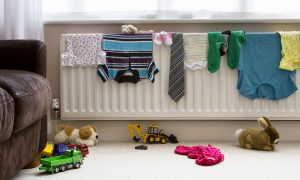If you’re like most people, the idea of hanging your laundry on radiators probably seems like no big deal. And if you’re already doing it, why change?
But it turns out that this seemingly harmless solution may actually be causing you more problems than you think. In fact, in some cases, the clothes dryer may even be preferable to hanging clothes on radiators.
Keep reading to find out more about the issues associated with hanging your laundry on radiators…


Costing you money
Piling clothes over radiators leads to reduced heating ability. Hooking a wire clothes airer on top of the radiator will increase heating capacity but will also form an obstruction and prevent all heat from getting into the room.
Besides, the added ventilation you’ll need in order to make up for adding the water vapour in your home will cause your house to be colder, and it’ll likely allow all that heated air that you paid for to escape.
However, it would be best to compare the total costs involved. In the end, you would have a higher running cost from the warmth from the radiator and repairs. If you compare to a tumble-dryer with a lower energy rating, like an A-rated, the energy will be about £30 per year and for a C-rated it would be about £100.
Condensation
The water evaporates out of wet clothes when they are hung to dry on a radiator or clothes horse, where it turns into moisture. When there is too much moisture in the air, condensation can form on walls, windows, mirrors, or any other surfaces the damp air contacts.
Modern homes often suffer from condensation because of improved insulation, draught-proofing and double-glazing, which cause stale air and trapped moisture, which can be both unpleasant and harmful.
Black mould
Since your clothes will be drying inside, the increased humidity from your clothes in the house can cause dampness, leading to mould growth in your house.
Mould can make you ill, affecting primarily your respiratory system as it emits spores which are then inhaled. Mould can also cause damage to your home, first by damaging painted and wallpaper, which starts to peel and blister.
If you have serious problems with damp or mould, it can destroy plaster walls or even rot your home. This may cost you anywhere from a few hundred pounds to thousands of pounds to repair.
Having trouble with mould in your house then you could follow these ‘6 cleaning methods’ to start with, but it is important to seek expert help- as mould can be dangerous.
How else can I dry my clothes?
You could dry your clothes on a washing line outside, if the weather permits. This is so the water can evaporate directly into the outside air instead of becoming trapped in your house.
Tumble dryers are a proven alternative, but they can be costly if used frequently.
You should properly vent your dryer outside to prevent steam from forming indoors. This will minimise the risk of condensation from your dryer. Consider purchasing a condenser tumble dryer, which does not require plumbing or venting as it condenses water within its own tank, which can then be emptied down the drain.
If you absolutely must dry your clothes indoors, make sure to do so in a well-ventilated room. Also you must avoid covering up any radiators in your home. You should never use an electric radiator heater to dry clothes as this poses a significant fire hazard.


Need help?
The experts at Switched On are here to help with all of your central heating needs. From boiler services to new radiators- we have you covered.
Simply ‘get in touch’ today for more information about any of our services.











